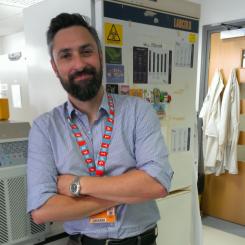Dr William English
University of Sheffield
Awarded: £24,677
Complete
The challenge
Cancers like sarcoma are a mix of lots of different cells including normal cells which are drawn to the cancerous cells and used to help the cancer develop. One of these types of cells is called a fibroblast. When fibroblasts are drawn into a tumour they help the cancer to grow and spread. They are also thought to be involved in hiding the cancer cells from the body’s immune system.
Not much is known about fibroblasts in soft tissue sarcoma tumours and they look very similar to cancer cells which makes them difficult to study.
How did this project tackle this challenge?
The project tried to tag the fibroblasts within the sarcoma tumours with a fluorescent marker to make them easy to spot and analyse. This is a method often used in other cancers. The team hoped to use this information to see exactly what the fibroblasts in the sarcoma tumours were doing which could suggest routes to treatment by targeting them.
Was it successful?
Not to begin with. Initially, the team could only see fibroblasts around the tumour, not within it. This meant that if these soft tissue sarcoma tumours did have fibroblasts they were very different to those in other cancers. The next step was to look at tumour cells from a different sarcoma subtype taken from patients. This was more successful, and differences were found between which genes were working in the sarcoma cells and the normal cells that had been pulled into the tumour.
What this means for people affected by sarcoma
The work is an early step into better understanding how normal cells are recruited by sarcomas and how they are different from other cancers. It also suggests ways that subtypes of soft tissue sarcomas differ from each other. This might help researchers to find new ways to diagnose or treat soft tissue sarcoma.
We know very little about what fibroblast cells do in sarcoma. The more we know about how fibroblasts affect the growth and spread of sarcoma, the better we can fight it.













